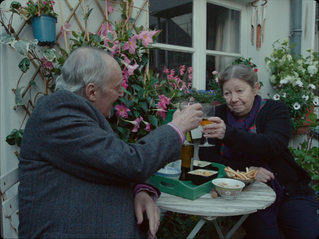The Age of Innocence
- Jessica Moore

- Sep 2, 2021
- 3 min read
Updated: Sep 11, 2021
Martin Scorsese, 1993

Time flies amidst forbidden glances; it floats atop sumptuous feasts; between cavernous houses and frosted winter nights. Bodies are swathed in silk and tulle; stood before a lighthouse at sunset or bouquets of flowers, drifting beneath candlelight, waltzing through enfiladed drawing rooms amongst paintings and whispers and regrets.
Edith Wharton describes souls to be naked; as unmapped regions. These ideas are encoded in Martin Scorsese’s luminous adaptation of her 1920 novel, The Age of Innocence. The plot is somewhat conventional: the respectable Newland (Daniel Day-Lewis) and the socially outcast Countess Ellen Oleska (Michelle Pfeiffer) are clandestine lovers. Together they constitute two-thirds of a love triangle, the final third being May Welland (Winona Ryder), Ellen's cousin, who is expected to marry Newland. Forced to publically uphold unwritten codes of social grace, Newland and Ellen sequester their passion. Marriages were entente cordiale, less to do with desire than with appearances and mobility. Together, Newland and Ellen embody scandal and disillusionment; they reveal to us the inhospitable milieu that strangles those who transgress.
And yet, it seems the subtleties of Wharton's novel are at odds with the fantastical nature of period filmmaking. One has a vastly different experience with the 1920 novel than with Scorsese's 1993 film adaptation, not simply because the novel and film exist in disparate cultures, but precisely because of their form.
Literary prose guides readers abstractly and internally — we conceive our own images that continually refine themselves. Despite their ambiguity, novels are thoroughly introspective. This is not to say that film is not introspective, but rather its aesthetic nature appeals to the senses; films confess themselves by being seen. Images spill outward. They involve us beyond the privacy of thought. In the words of Joan Didion, if novels say “I”, imposing themselves onto the reader, perhaps films, due to the visual exchange they initiate, say “you”.
Audiences of period literary adaptations, as opposed to readers of the original novels, are continually reminded that what they are watching is a display evoking not merely another time, but a time upon a stage — a museum of actors “acting” in every sense of the word. Unlike the private directness of literature, or the veracity of Wharton’s observations of the society around her, Scorsese’s film adaptation sees fiction laid upon fiction, it sees the source material shaped by his own artistic sensibilities; he was inspired by Visconti's Senso and Welles’s The Magnificent Ambersons. Rife with cinephilic impulses, Scorsese's adaptation is overwhelming — verging on crowded.
By 1993, following the release of Taxi Driver and Raging Bull, Scorsese was best known for films that wrestle with sordid machismo, sectarianism and alienation in contemporary New York, and so embarking on the reticent culture of 1870's aristocracy came as quite the surprise. Though Wharton was a fellow New Yorker, Scorsese's name attached to her novel only adds to the adaptation's unlikeliness, its theatricality.

Period adaptations focused on high society are especially histrionic, exciting audiences precisely through the opulence of their set designs and costumes; urging a suspension of belief that is, to the genre’s most devoted followers, utterly enticing. Perhaps period adaptations succeed when this belief, this cognisance of pretending, is not ignored but rejoiced; when audiences do not pore over historic references, deliberating their truth, but relish them for what they are: decorative, figments of a director’s subjectivity. Period adaptations flourish when their audiences are encouraged to bask in the cinematic spectacle as it is: as a piece of art entirely self-aware — awash with fiction, boasting a painterly sheen.
Few directors of period cinema, only those who are so ambitious, are able to balance undeniable visual appeal and genuine immersion. Merchant-Ivory established this balance throughout the preceding decade, though their films depart rather dramatically from Scorsese's. Indeed, Scorsese's adaptation is as much a study on cinema itself as it is a narrative feature. It is a scholarly attempt to transcend the space between text and image; it is intentionally and decisively elevated by both mediums.
In his adaptation, Scorsese overcomes potential obstacles, of an ensemble cast and operatic extravagance, and crafts a film that is intricately emotive, far richer in humanity than is possible in simply magnifying a distant culture.
Illuminated by Wharton's prose that is narrated throughout, experiencing Scorsese’s film feels like being guided through a series of drawing rooms overcrowded with paintings, as accompanied by a deciphering voice that draws our attention to the subtleties of their texture and composition; details which we would have otherwise failed to notice.
Despite the novel's anthropological conscience, Scorsese's The Age of Innocence is not merely a glimpse into another world foreign to our own. We do not swing between then and now as conscious time-travellers, we instead peer inside a spectral vista, of bodies beating onward — amongst the grandeur and decay.








Comments